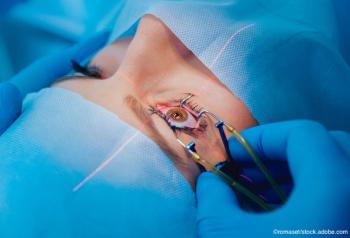
Better management of white cataracts with these pearls can help avoid complications like the Argentinian flag sign.

Better management of white cataracts with these pearls can help avoid complications like the Argentinian flag sign.

Treatment based on the findings of a thorough history, appropriate testing, and clinical exam can be successful for bringing relief to many problem dry eye patients.

Joseph Tauber, MD, offers a critical appraisal of the role of available point-of-care tests for evaluating dry eye.

Spectral-domain optical coherence tomography is useful for diagnosing early keratoconus because it detects characteristic changes in epithelial and stromal thickness.

Mitomycin C, when used in accordance with the approved guidelines, can be beneficial but can cause haze with long exposures and higher concentrations.

Intraoperative aberrometry may reduce refractive surprises and result in a higher percentage of happy patients following cataract surgery, particularly those who had undergone previous corneal refractive surgery and in those planning for a toric IOL.

Ocular surface disease and health are affected by numerous interactions and cascades with complex mechanisms in disease states.

In head-to-head clinical assessments, alcaftadine was found to be statistically and clinically superior to olopatadine for relief of allergic conjunctivitis.

A recent study explored the potential of a novel ophthalmic emulsion in dry eye subjects dosed twice daily for 2 weeks.

A topical epithelial sodium channel blocker is being investigated in a phase I/IIa clinical trial as a novel treatment for dry eye disease.

A number of clinical trials are focusing on various medical uses for contact lenses. The latest updates on these and other studies are always accessible via clinicaltrials.gov.

Corneal confocal microscopy (CCM) has been found to predict peripheral neuropathy in patients with type 1 diabetes, according to a recent study.

The FDA has approved Genentech’s ranibizumab injection (Lucentis) for the treatment of diabetic retinopathy in patients with diabetic macular edema (DME).

Answer lies in attention to candidate selection, counseling, and IOL positioning

New technology can help ophthalmologists care for their patients if they combine it with a personal touch, said Paul P. Lee, MD, JD, in the Shaffer-Hetherington-Hoskins Lecture during the Glaucoma 360 CME Symposium.

Even the best ophthalmologists must prepare to support patients who lose vision while in their care, said Robert L. Stamper, MD.

Insurers are funneling patients to providers based on cost and quality data that may not always be accurate, said Ruth D. Williams, MD.

The development of stem cell treatments for glaucoma faces big hurdles, but researchers are making rapid progress, said Yvonne Ou, MD.

Gary D. Novack, PhD, president of PharmaLogic Development, co-moderated an industry panel discussion on glaucoma pharmaceuticals Friday during Glaucoma 360. Watch Dr. Novack outline the state of glaucoma drug therapy and where the future is headed.

A team of researchers may soon be able to catch glaucoma cases early by spotting nerve damage, said Andrew D. Huberman, PhD, as he provided an update on the work of the Glaucoma Research Foundation’s Catalyst for a Cure Biomarkers Initiative at the Glaucoma 360 New Horizons Forum.

Ophthalmologists must change the way they use data in order to meet the mounting challenges facing their profession, said Paul P. Lee, MD, JD, in the Drs. Henry and Frederick Sutro Memorial Lecture at the 4th Annual Glaucoma 360 New Horizons Forum.

Glaucoma 360 is an all-encompassing event in which clinicians, scientists, industry, and business converge in one direction to discover a cure for glaucoma.

For his efforts to prove that gene therapy could one day provide lasting control of IOP in patients with glaucoma with known genetic defects, Andras M. Komáromy, PhD, DVM, was awarded the 2015 Shaffer Prize for Innovative Glaucoma Research.

Glaucoma Research Foundation (GRF) honored a long-time global leader in ophthalmology with its Catalyst Award on Thursday night at the foundation’s Glaucoma 360 Annual Gala and presented two renowned stem-cell researchers with its Visionary Award.

Analysis of the Harbor Study data could not definitively answer the question about whether anti-vascular endothelial growth factor (VEGF) therapies influence the development of atrophy in patients with neovascular age-related macular degeneration (AMD). However, investigators did find that the visual acuity (VA) continued to improve in patients treated with monthly and as-needed drug regimens and that certain risk factors can predict development of atrophy, according to Srinivas Sadda, MD.

Michael S. Ehrlich, MD, explains how a simple lacrimal irrigation technique not only can avoid unnecessary discomfort for patients, but also adds diagnostic value for ophthalmologists.

An office-based system (NOVA Testing System, Diopsys) represents an advance in electrophysiological technology that allows clinicians the ability to detect pathology they have been unable to see in the past, thereby detecting disease early.

How does a practice remedy a long waiting time for patients? First, you must be concerned and communicate it to the staff. Physicians should watch or “visit” the reception area periodically to see if there is a “crowd.” Look at the patient’s scheduled time and monitor this regularly. Of course, the physician also should get to the office a little early and be ready to see the first patient when he/she is ready.

Peripheral melting disorders require surgical intervention when all else has failed and there is an impending risk of perforation. A peripheral C- or banana-shaped graft can restore tectonic integrity while maintaining a reasonable corneal contour to preserve vision.

New devices to lower IOP and facilitate aqueous outflow via minimally invasive glaucoma surgery are being developed, and early results from clinical trials are favorable for some.